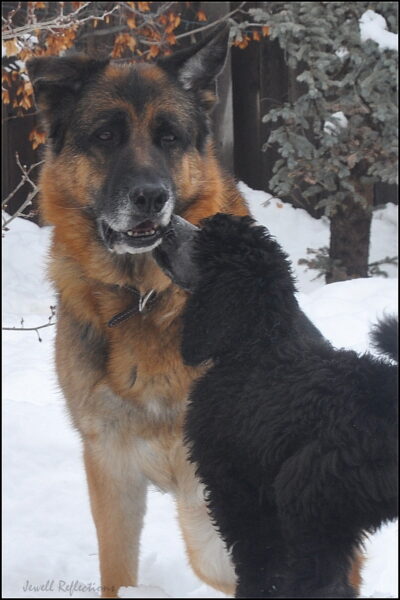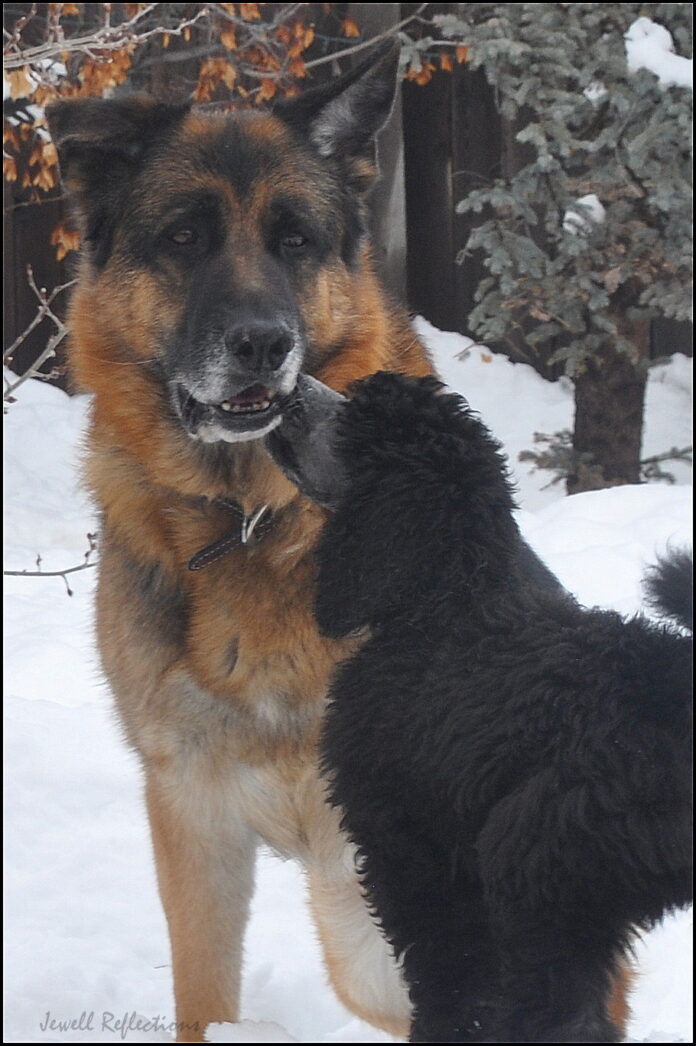By Fran Jewell

Many people these days have or will have multiple-dog households. In addition, we meet other dogs along the trails all the time. This means that our dogs must learn how to meet and greet appropriately, with the outcome being healthy relationships. Having said that, I also believe, strongly, that many dogs are not social and do not want relationships with other dogs. When we find we have a dog that does not like other dogs, it is our job in all fairness to not push those relationships on them.
The idea that “just let them work it out” is actually very unfair to the dogs. Many dogs that could be fearful, over-friendly, dominant or bullies will not work it out fairly or in a healthy manner. In those cases, letting them work it out for themselves is an open door to disaster.
Many people don’t recognize the signs that a disaster is about to happen. Why? Because we are not dogs. Dogs speak to each other so quickly and in a different language, it can be hard even for a dog behavior expert to catch all the communication between two dogs!!!! As a certified dog behavior consultant, I watch and live with dog behavior full time, even in my home. Still, I can and do miss the dog spoken language; it is not easy to see and interpret accurately.
There is huge pressure for our dogs to get along in today’s environment because almost everyone has one or more dogs and they are all out in public areas. Just like people, some dogs are New York City dogs that love being with lots and lots of dogs. Other people and dogs are country dwellers that would rather have the peace of solitude, going into a small town only once in a while.
When we leave dogs to their own devices about meeting new dogs, things can become very dicey.
What is the solution? In my home, dogs are introduced slowly. I let them build trust with each other. If a new dog comes into my home, that dog is placed in an exercise pen in the living room so it can sniff and see the other dogs safely. I may actually do this for a couple of days. It depends on the comfort I see. I also have an exercise pen outside for the new dog to be safe in until it can see and experience the dog dynamics safely. Very rarely do I ever just put the dogs in together and let them “work it out.”
However, an exercise pen is not a possibility for dogs that are loose on the trail. One of the best things you can do in that situation is to just keep walking. If you stop and let the dogs sniff, that is when a conflict can arise. If you keep going, and reward your dog frequently for coming along with you, no matter what, it takes the pressure off both dogs so they can feel safer and avoid conflict.
In the world of dog behavior, there is no 100 percent way to do anything. Each dog is individual and must be treated as such. Some dogs need more leadership to feel safe. Other dogs may need more leadership so they are not the ones making decisions. And some dogs are, indeed, really easy about being with other dogs. Knowing your dog and being intentional and having a plan ahead of time about dog-to-dog greeting is essential.
The more dogs there are, the more the chance of conflict, fights and injury. Dog-to-dog greetings are not something we as owners should take lightly.
Fran Jewell is an Idaho Press Club award-winning columnist, IAABC-certified dog behavior consultant, NADOI-certified instructor #1096 and the owner of Positive Puppy Dog Training, LLC, in Sun Valley. For more information, visit www.positivepuppy.com or call (208) 578-1565.



